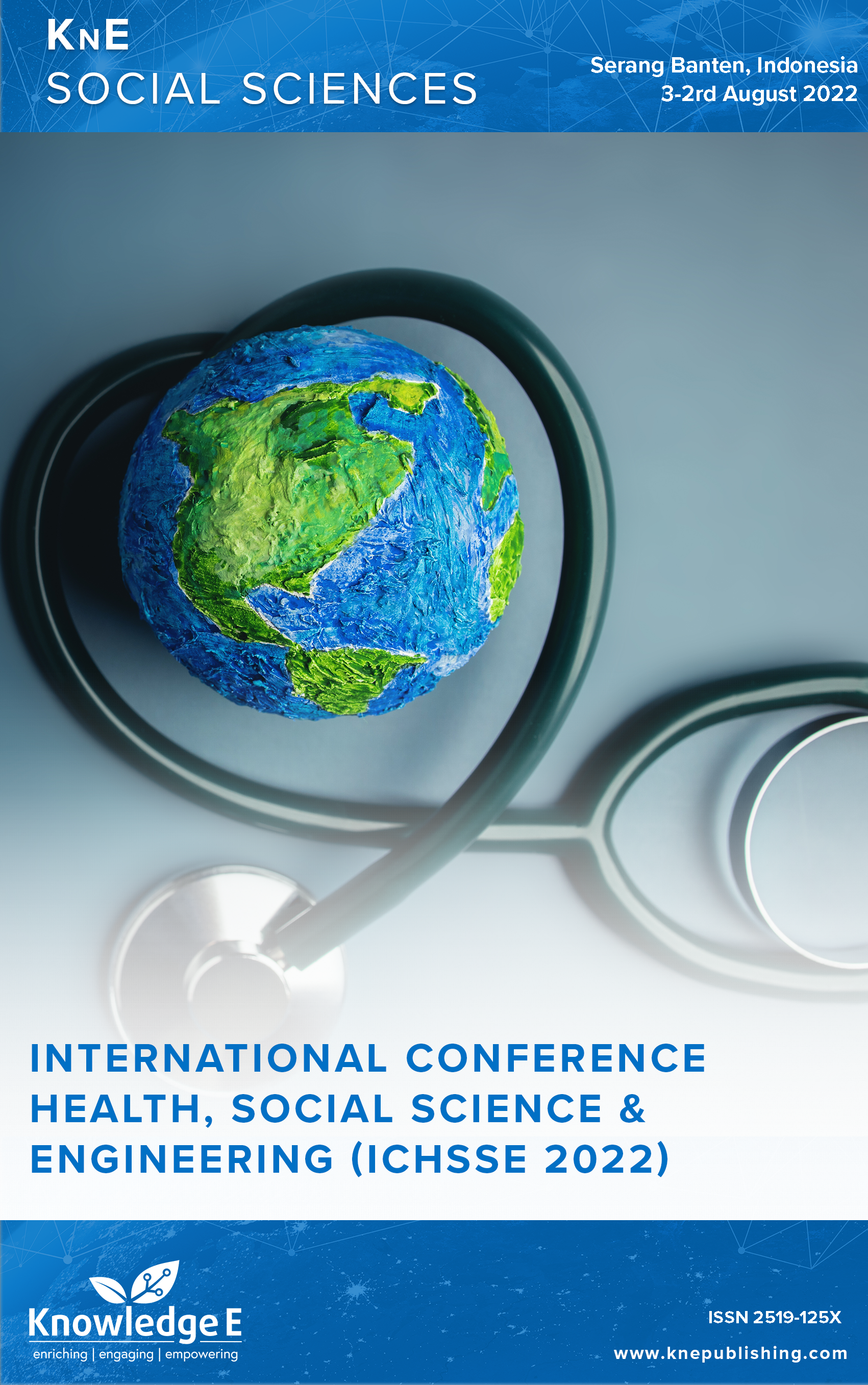Implementation of 5S (Seiri, Seiton, Seiso, Seiketsu, and Shitzuke) in Workers
DOI:
https://doi.org/10.18502/kss.v8i14.13824Abstract
The implementation of the 5S concept (Seiri, Seiton, Seiso, Seiketsu, dan Shitzuke) is one of the efforts to prevent accidents in the industry by making the work environment safe and comfortable. This research aims to analyze the implementation of 5S on workers. This study used a cross-sectional design with a total sample of 75 people. The results showed that 52% respondents applied the 5S concept well, 84% respondents were male, 76% respondents had new work period, 84% respondents had low education, 58.7% respondents had good knowledge, 92% respondents had a positive attitude, and 66.7% respondents had strong work motivation. The results of this research said that there was a correlation between gender (P-value = 0.007), and work period (P-value = 0.037) with the application of 5S to workers. The results of statistical tests also showed that there was no significant value between education level (P-value = 1,000), knowledge (P-value = 0.771), attitude (P-value = 0.099), and work motivation (P-value = 0.806) with the application of 5S to workers. Management needs to be more committed in implementing 5S by increasing supervision, making safety signs, and providing 5S training, especially for male workers and workers who have a long working period so that they can implement 5S properly.
Keywords: implementation of 5S, workers, work period
References
[2] Naji GMA, Isha ASN, Mohyaldinn ME, Leka S, Saleem MS, Syed Abd Rahman SMNB, et al. “Impact of safety culture on safety performance; mediating role of psychosocial hazard: An integrated modelling approach.” Int J Environ Res Public Health. 2021;18(16). doi: 10.3390/ijerph18168568.
[3] Japanese T. “5S as the culture of Japanese Work.” 2 Februari, 2018. https://www.lensasoftware.com/5s-as-the-culture-of-japanese-work/.
[4] Setiawan PA, Penerapan 5S di Tempat Kerja: Pendekatan Langkah-Langkah Praktis. 2010.
[5] Sandika OD, Wijayanto DS, Harjanto B. “Implementasi Budaya 5R (Ringkas, Rapi, Resik, Rawat dan Rajin) Di Unit Machinery and Tool (UMT) PT. Mega Andalan Kalasan.” J Chem Inf Model. 2019;53(9):1689–1699.
[6] Kanamori S, Sow S, Castro MC, Matsuno R, Tsuru A, Jimba M. “Implementation of 5S management method for lean healthcare at a health center in Senegal: A qualitative study of staff perception.” Glob Health Action. 2015;8(1). doi: 10.3402/gha.v8.27256.
[7] Umroh AH, Indah MF, Anam K. “The relationship between aplication of 5R programe with accident in constraction worker in PT. PP-WIKA,” Banjarmasin, 2019. [Online]. Available: http://eprints.uniska-bjm.ac.id/547/2/ARTIKEL-dikonversi %281%29.pdf.
[8] Elyanti N. “Determinan Perilaku 5R (Ringkas, Rapi, Resik, Rawat, Rajin) Pada Perawat Kelas III Di RSUD Pasar Rebo Jakarta.” Progr Stud Kesehat Masyarakat Fak Kedokt dan Ilmu Kesehatan Univ Islam Negeri Syarif Hidayatullah Jakarta. 2017;6.
[9] Putri GDP. Motivasi Kerja Dengan Penerapan 5R Pada Pekerja Di Indudtri Kerupuk Rambak Dusun Krajan Kelurahan Mangli Kecamatan Kaliwates Jember. 2019.
[10] Rosnasari AD, Dewi ER. “Hubungan Pengetahuan Motivasi Dan Sikap Kerja Dengan Pelaksanaan Program 5R Unit Paper Mill 5/6/9 PT. Pura Barutama Kudus.” Sekol Tinggi Ilmu Kesehat Cendekia Utama Kudus, 2017.
[11] Rantung AR, Pinontoan OR, Suoth L. “Ratulangi oleh pt. Adhi Karya (PERSERO) TBK Pendahuluan Salah satu upaya dalam pelaksanaan K3 yaitu dengan menciptakan tempat kerja yang aman , dan dari pemerintah Indonesia . PT. Adhi Karya (Persero) Tbk memulai proyek pembangunan gedung Universita.” 2018;7(5).
[12] Bate J, Rasmussen E. “Health and safety at work.” The Health and Safety Executive, 2019.
[13] Kemenaker. “Menaker: Jadikan K3 Sebagai Prioritas Dalam Bekerja.” kementrian Ketenagakerjaan Republik Indonesia. 2019.
[14] Redaksi. “Pemrov Banten Minta Utamakan Keselamatan dan Kesehatan Kerja.” EksisBanten.com, 2020.
[15] Khaqiiqudin MG, Wahyuni I, Kurniawan B. “Relationship among characteristic of workers housekeeping. Availability and use personal protective equipment against minor injury events.” J Kesehat Masy. FKM UNDIP. 2019;7(4):239–245. [Online]. Available: https://ejournal3.undip.ac.id/index.php/jkm/article/view/24385.
[16] Laminia D, Muniroh L. “Relationship of motivation and work period with workers productivity at home industry.” Indones J Occup Saf Heal. 2018;7(2):240. doi: 10.20473/ijosh.v7i2.2018.240-248.
[17] Widyanti R, Pertiwi WE. “Analysis determine of minor accidents at operator and maintenance worker.” J Ilm Kesehat. 2021;20(2):58–65. [Online]. Available: https://journals.stikim.ac.id/index.php/jikes/article/view/753.
[18] Notoatmojo S. Promosi Kesehatan dan Perilaku Kesehatan. Jakarta: Rineka Cipta, 2012.
[19] Pradono J, Sulistyowati N. “Correlation between education level, knowledge of environmental health, healthy behavior with health status.” Bul Penelit Sist Kesehat. 2013;17(1):89–95.
[20] Akbar RF. “The analysis of active learning with collaborative learning in education management course in STAIN Kudus.” J IAIN Kudus. 2017;53(9):19–38. [Online]. Available: www.journal.uta45jakarta.ac.id.
[21] Septaviani R. “Factors related with 5S (Seiri, Seiton, Seiso, Seiketsu, Shitsuke) aplications in motorcycle shop technician, Semarang City.” J Kesehat Masy. 2012;1(2):785–792.
[22] s Notoatmodjo. Ilmu perilaku kesehatan kesehatan. jakarta: rineka cipta, 2014.
[23] Wahyudi D, Pertiwi WE. “Sikap Pengemudi Dump Truck Terhadap Safety Driving.” Media Kesehat Masy Indones. 2021;20(2):134–138. doi: 10.14710/mkmi.20.2.134-138.
[24] Hasibuan MS. Organisasi dan Motivasi Dasar Peningkatan Produktivitas. Jakarta: Sinar Grafika Offset, 2014.
[25] Samsudin S. Manajemen Sumber Daya Manusia. Bandung: Penerbit Pustaka Setia, 2010.

